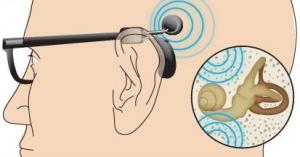Tous droits réservés © NeurOreille (loi sur la propriété intellectuelle 85-660 du 3 juillet 1985). Ce produit ne peut être copié ou utilisé dans un but lucratif.
Hearing aids have a fundamental role in the rehabilitation of sensorineural hearing loss, but also some conductive hearing losses. However, it is important to determine their limits, particularly in the case of severe sensorineural hearing loss.
Various types of hearing aid exist to address different needs. In some conductive hearing losses, a bone conduction hearing aid that can stimulate the ear by transmitting sound vibrations through the bone of the skull can be used. In most other cases, conventional hearing aids that use air conduction are used.
Conventional hearing aids (air conduction)
These work by first capturing sound vibrations via one or more microphones. The signal is treated, amplified, and played back via an earphone placed in the ear canal. They come in different shapes, with varying power and levels of sophistication, and the choice of these characteristics depends upon the level of hearing loss, but also the environment that the person with hearing loss lives in.
Bone conduction hearing aids
These consist of either special bone-conduction glasses or a headband, or a bone anchored hearing aid (BAHA).
Used in certain cases of conductive hearing loss, these devices use bone's intrinsic ability to conduct vibrations. Sound vibrations are captured by a microphone and transmitted directly to the temporal bone via a vibrator situated behind the ear. In this way, the vibration of the bone surrounding the inner ear is transmitted to the cochlea and the hair cells.
Implants à ancrage osseux
Un boitier, contenant le microphone, le processeur et le système vibrant, est clipsé sur une vis en titane mise en place chirurgicalement dans l'os située derrière l'oreille. Ce système d'accroche améliore nettement la conduction osseuse car il n'y a plus les contraintes cutanées. En outre, ces aides ont une plage d'application restreinte à un certains types de surdités et nécessitent certaines précautions quant à d'éventuelles infections cutanées au niveau du pilier.
Bone anchored hearing aid
A small box, containing the microphone, processor and vibrator, is clipped onto a surgically-implanted titanium screw behind the ear. Attaching the device in this way drastically improves bone conduction, as there are no problems with transmitting through the skin. In addition, the use of these hearing aids is restricted to certain types of hearing loss and require certain precautions to minimise the risk of infection.
Middle ear implants
In a similar way to bone conduction hearing aids, sound is captured and causes the vibrator to move. In this case, the latter is fixed to one of the ossicles, meaning that normal movement of these tiny bones is restored or even amplified, and sound is transmitted to the inner ear normally. The use of these devices is also limited by factors such as the severity and type of hearing loss, the absence or damage of the ossicles…
Hearing aid limitations in sensorineural hearing loss
It is important to understand that hearing aids, although they work very well, only work by improving the transmission of sound waves to the inner ear. They are therefore very useful in treating conductive hearing loss. In the case of sensorineural hearing loss, they allow a damaged cochlea to draw the maximum amount of information from the stimulus. However, if the loss of sensory cells, or neurons, is too great, the quality and the performance of the messages sent to the brain will be insufficient to allow normal hearing.
Note. This can be compared to the visual system. A pair of glasses corrects 'transmission' errors perfectly, such as in short- or long-sightedness, but no matter how sophisticated they are, glasses cannot return normal vision if there is a problem with the retina!
 Français
Français
 English
English
 Español
Español
 Português
Português



Facebook Twitter Google+